Survey Report
CHROs and Top Executives
The trend toward working remotely since the start of the COVID-19 pandemic is likely to continue indefinitely post-pandemic, with 42% of Chief Human Resource Officers (CHROs) indicating a quarter to one half of their workforce will continue to work remotely indefinitely after the pandemic, five times more than said so about their pre-pandemic workforce.
This is one of the key findings from our recent survey of 545 Director, S/VP, and C-suite executives, and 111 Human Resources professionals. The purpose of the survey was to gauge respondents’ intentions and understand their plans for employees to return to the workplace.
This report presents our analysis and insights, and compares and contrasts responses from executives with those of CHROs and HR leaders charged with developing and implementing the plan for their workers to return.
The sample came from more than 11,000 executives and CHROs in our extensive network who are actively engaged in a variety of industries across the nation. Respondents of the survey self-selected from a direct invitation to respond.

42% of Chief Human Resource Officers (CHROs) said a quarter to one half of their workforce will continue to work remotely indefinitely after the pandemic, five times more than said so about their pre-pandemic workforce.
Executives and CHROs shared similar feelings relating to the challenges of working remotely, including comments about feelings of social isolation, lacking collaboration and teamwork with co-workers, “Zoom fatigue,” and access to specialized office equipment.
73% of executives say they are working remotely since the pandemic, more than 15 times those who said they did before the pandemic.
96% of CHROs are developing or are already implementing their organization’s plan for workers to return to the office, with 70% planning to bring employees back within 90 days. However, 22% of CHROs said they have not yet determined a time frame for when workers will come back to the office.
HR leaders (99%) say they have no problem onboarding new talent remotely. Yet, more than 14% of CHROs said they lack the necessary planning or tools to onboard new employees remotely.
Leaders are reluctant to consider a career move. Most executives (64%), said they would not be interested in considering a career move during the COVID pandemic. Yet, for the right opportunity, 57% said they would accept a job without ever meeting the manager face-to-face or experiencing the workplace environment.
A remote-only job opportunity holds greater appeal than relocating to a new job. The majority of executives (66%) said they would not accept a position that would require relocating, but 82% said they would accept a position that was remote-only.
Executives placed less importance than CHROs on childcare support and more importance on off-hours access, indicating that they are willing to put in the necessary effort required even when working remote
42% of Chief Human Resource Officers (CHROs) said a quarter to one half of their workforce will continue to work remotely indefinitely after the pandemic, five times more than said so about their pre-pandemic workforce.
Executives and CHROs shared similar feelings relating to the challenges of working remotely, including comments about feelings of social isolation, lacking collaboration and teamwork with co-workers, “Zoom fatigue,” and access to specialized office equipment.
73% of executives say they are working remotely since the pandemic, more than 15 times those who said they did before the pandemic.
96% of CHROs are developing or are already implementing their organization’s plan for workers to return to the office, with 70% planning to bring employees back within 90 days. However, 22% of CHROs said they have not yet determined a time frame for when workers will come back to the office.
HR leaders (99%) say they have no problem onboarding new talent remotely. Yet, more than 14% of CHROs said they lack the necessary planning or tools to onboard new employees remotely.
Leaders are reluctant to consider a career move. Most executives (64%), said they would not be interested in considering a career move during the COVID pandemic. Yet, for the right opportunity, 57% said they would accept a job without ever meeting the manager face-to-face or experiencing the workplace environment.
A remote-only job opportunity holds greater appeal than relocating to a new job. The majority of executives (66%) said they would not accept a position that would require relocating, but 82% said they would accept a position that was remote-only.
Executives placed less importance than CHROs on childcare support and more importance on off-hours access, indicating that they are willing to put in the necessary effort required even when working remote
Responses from executives consisted primarily of high-level employees: 98% at the Director, SVP or VP, or C-Suite level.
What is your current employment level? (Executives)
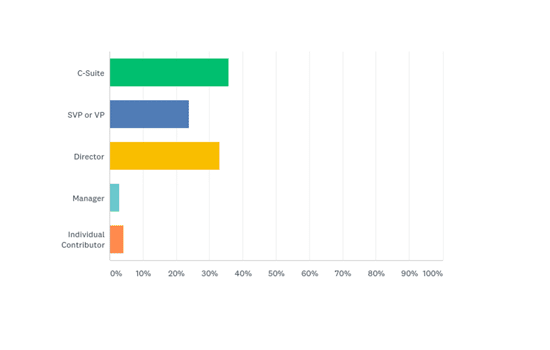
Where are you currently located? (Executives)

Northeast and Mid-Atlantic states accounted for the majority of respondents from both candidates (84%) and CHROs (84%).
Where are you currently located? (Executives)

Where are you currently located? (CHROs)
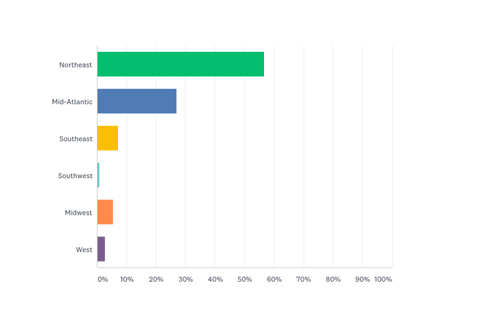
The top 3 functional areas indicated by candidates include Human Resources (29%), General Management (21%), and Finance (14%), in the top 3 industry sectors, Manufacturing (15%), Hospital/Health System (13%), and Life Sciences (13%).
What is your current functional area? (Executives)

In which industry sector are you currently employed? (CHROs)

The top 3 industry sectors indicated by CHROs were Manufacturing (22%), Life Sciences (14%), and Financial Services (13%).
In which industry sector are you currently employed? (Executives)
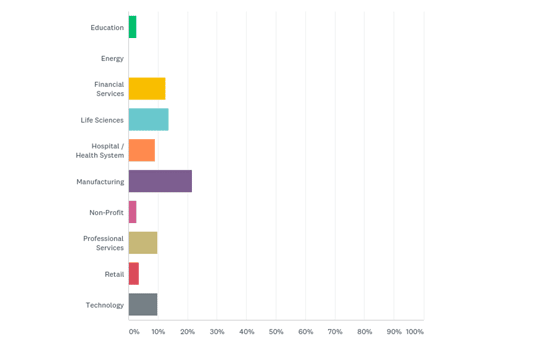
Most candidates (98%) said they are currently employed full time. Less than 1% were either furloughed or unemployed.
Which of the following best describes your current employment status: (Executives)

Given recent stay-at-home recommendations in many states, it’s not surprising that most executives (94%) said they are currently working remotely, or a mix of remote and in-office.
73% of these leaders say they are working remotely since the pandemic, more than 15 times those who said they did before the pandemic.
Comments indicate that, for some, working remotely is a new experience.
“Our business office has been working remotely since mid-March due to COVID-19”
“Full-time WFH since March 13”
“Will be going back to office when county moves to yellow.”
For others, working remotely is business as usual.
“I work mostly from my home office, and am typically at the company once or twice a week.”
“I have worked from home office for 20+ years.”
“Have been in sales role, and 75% of work with clients had been via phone/Zoom anyway. The 100% works fine…no lunches with clients, and more time spent on Zoom than phone, but that is working OK for the moment.”
Which of the following best describes your current work environment: (Executives)

Prior to the ongoing pandemic crisis, which of the following best describes your work environment: (Executives)

42% of Chief Human Resource Officers (CHROs) said a quarter to one half of their workforce will continue to work remotely indefinitely after the pandemic, five times more than said so about their pre-pandemic workforce. This may indicate that the trend toward working remotely will become more commonplace.
“I am able to do most of my usual work from home.”
“Full-time WFH since March 13th.”
What percentage of your workforce worked remotely before the current pandemic crisis? (CHROs)
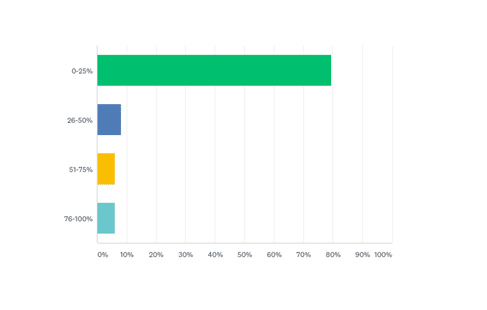
What percentage of your workforce will continue to work remotely indefinitely? (CHROs)
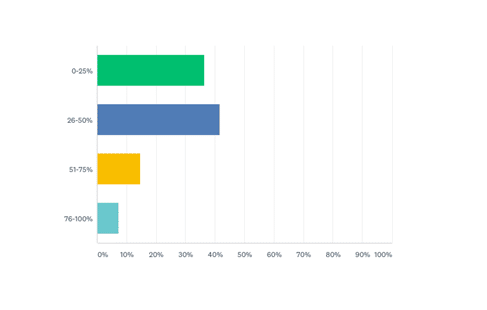
96% of CHROs are in the process of developing or are already implementing their organizations’ plan for workers to return to the office, with 70% planning to bring employees back to the office within 90 days.
However, 22% of CHROs said they have not yet determined a time frame for when workers will come back to the office.
Many comments indicate a phased approach for employees to return to their workplace, depending on conditions in specific regions.
Have you begun your organization’s return to work plan? (CHROs)
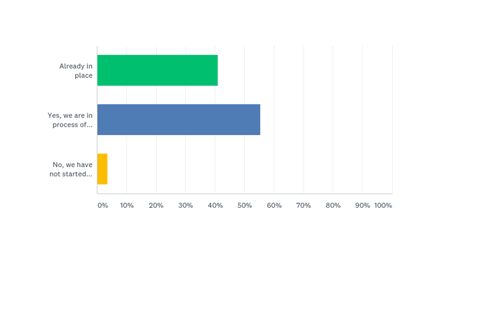
When do you plan to start bringing people back on-site? (CHROs)
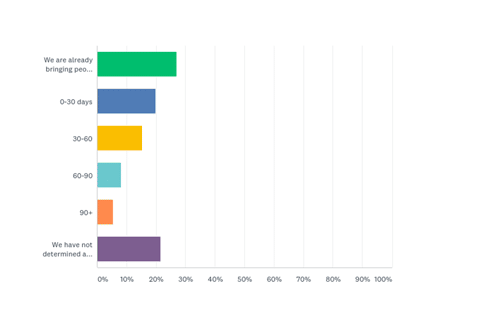
HR leaders (99%) say they have no problem onboarding new talent remotely. Yet, more than 14% of CHROs said they lack the necessary planning or tools to onboard new employees remotely.
Would you consider onboarding new talent, if needed, in a remote environment? (CHROs)
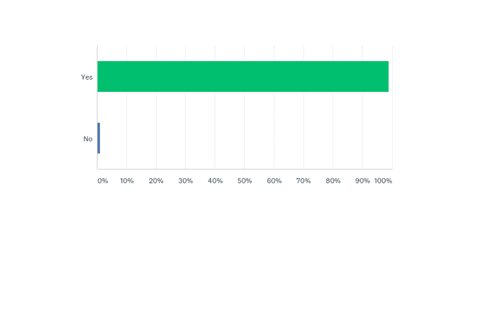
Do you have virtual onboarding plans and tools in place? (CHROs)
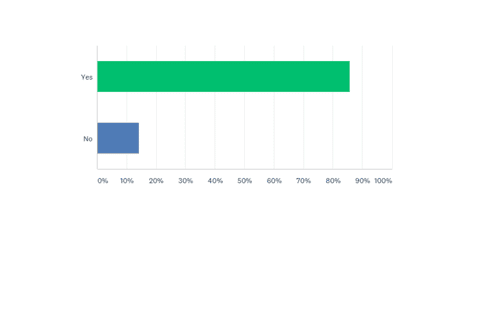
Most executives (64%) said they would not be interested in considering a career move during the COVID pandemic. Yet, for the right opportunity, 57% said they would accept a job without ever meeting the manager face-to-face or experiencing the workplace environment.
“It would take a unique situation in this environment to take on
more personal risk and family disruption.”
“Too much uncertainty.”
“I am not interested in a career change during COVID but would be
open to new opportunities in 2021.”
In middle of the COVID pandemic, are you interested in considering a career move? (Executives)

Would you accept a job without meeting your manager face-to-face and experiencing the workplace environment? (Executives)
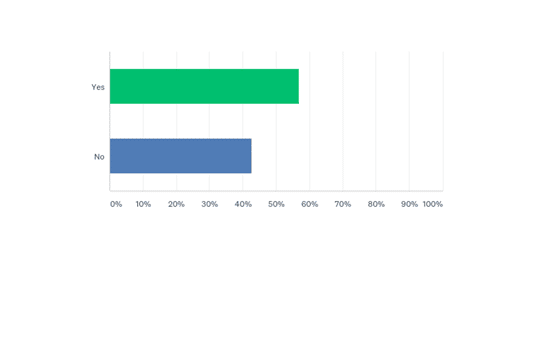
A remote-only job opportunity holds greater appeal than relocating for a new job. The majority of executives (66%) said they would not accept a position that would require relocating, but 82% said they would accept a position that was remote-only.
Would you be willing to accept that position if you were required to relocate? (Executives)

Would you accept a position that was remote-only for the foreseeable future? (Executives)

Most executives say they have the tools and technologies and are prepared to work effectively from home for the next 3 to 12 months.
Do you feel you have the technology and tools to conduct your work in a virtual environment? (Executives)

Are you prepared to effectively work from home for the next 3-12 months? (Executives)
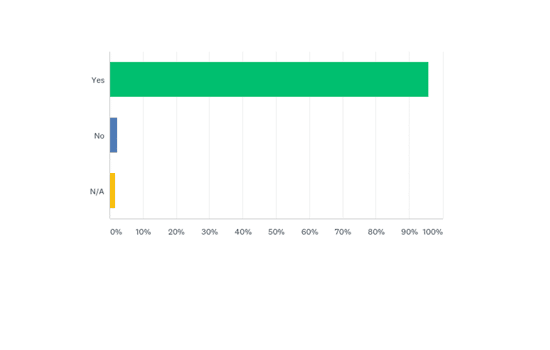
For comparison, we categorized various tools and technology required for working remotely as hard or soft. We defined hard tools as items such as technology, hardware or software, Internet connectivity, and office furniture and supplies. Soft tools include emotional support, collaboration, childcare support, flexible hours, and off-hours access.
Both CHROs and executives rated both hard and soft items closely with only minor differences in most areas. Surprisingly, on the whole, executives placed greater importance on hard tools (5.46% executives vs. 5.06% CHROs on average) while CHROs ranked soft tools more importantly (4.19% CHROs vs. 3.95% executives on average).
Interestingly, leaders placed less importance than CHROs on childcare support, and more importance on off-hours access, indicating that they are willing to put in the necessary effort required even when working remotely.
Rank the following in order of need for working most effectively from home (please rank from most important to least important): (Executives)
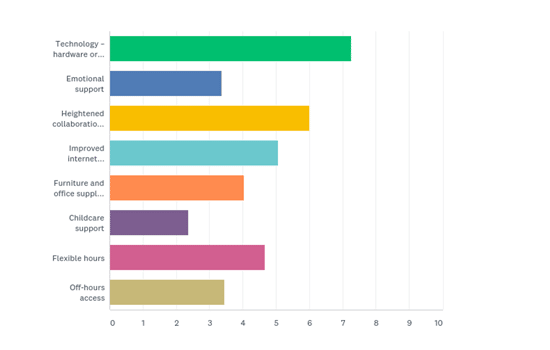
When designing a virtual work environment, which of the following do you find most important for your team members (please rank from most important to least important): (CHROs)
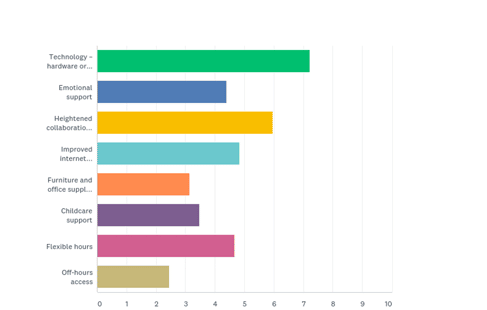
We asked executives and CHROs, “What is the greatest challenge related to working remotely?” Both groups shared similar feelings relating to the challenges of working remotely, including comments about feelings of social isolation, lacking collaboration and teamwork with co-workers, “Zoom fatigue,” and access to specialized office equipment.
*Note: All responses are copied and pasted verbatim. None of the responses have been proofed for grammar or spelling.
In your opinion, what is the greatest challenge related to working remotely?
Having my child at home.
Getting my family (kids) to be quiet when I am on a call/video conference.
Initially, the ability to stay organized and focused was a bit of a challenge, along with the ability to easily communicate with co-workers. As time goes by, it is becoming more routine and I’ve been able to develop processes to ensure as much efficiency as possible.
Social isolation.
From a management perspective, keeping insight into your employees’ needs, both personally and professionally.
Solidity of VPN connection.
Staying connected to colleagues and working together.
Building and maintaining effective teamwork among peers and direct reports.
It’s more difficult to have the impromptu water cooler type conversations. These conversations are often important informal communication channels and opportunities to build relationships.
*Note: See all the answers when you download the report.
Lack of robust collaboration tools; lack of spontaneous dialog and brainstorming; social interaction/teaming
Loss of culture – there is no way to build the same level of corporate culture and spirit when a company is 100% remote.
Feeling connected
Managing productivity
Isolation and negative impacts on collaboration, culture and productivity
Decreased efficiency, erosion of culture and social isolation
Managing productivity
Childcare for those who are trying to teach, caregive, and work.
The associate engagement.
Keeping the team building and collocation going in a different format than most employees are used to.
*Note: See all the answers when you download the report.
Given recent stay-at-home guidelines, it’s not surprising that many people are working from home. But as communities begin to reopen, HR leaders are testing their re-entry to work plans.
HR leaders are recruiting and onboarding new employees remotely, but some need additional planning and tools.
Executives are reluctant to relocate during the pandemic. But remote-only jobs hold greater appeal. And for the right opportunity, many leaders say they would accept a job without ever experiencing the environment or meeting their manager face-to-face.
Expect remote work to become much more commonplace post-pandemic.
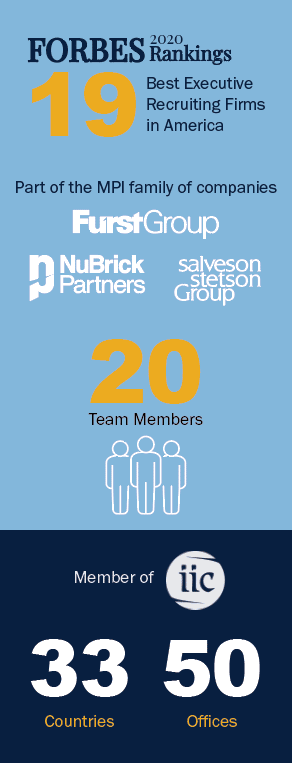
Salveson Stetson Group (SSG) is a multi-specialty, retained executive search firm located in Radnor, Pennsylvania, that delivers strategic, high-quality, responsive consulting and support for clients across the country and globally. Working across diverse industries, SSG has a long history of conducting executive-level human resources, clinical, scientific, finance, sales and marketing, and general management searches. With a team of 20 colleagues, necessary resources are dedicated for each assignment to exceed client expectations.
SSG embodies a rare and powerful value for clients in terms of client and candidate experience. As a firm actively led by its two principals, SSG delivers the kind of strategic, responsive consulting services expected from a large search firm with the tailored attention and support of a boutique firm.
As part of the MPI family of companies, SSG has access to talent, resources, and expertise on a national level through our sister companies – Furst Group and NuBrick Partners. Furst Group, a retained executive search firm, is focused on identifying senior-level executives for the healthcare industry. NuBrick Partners is a leadership consulting firm focused on executive team performance, strategic team development, board effectiveness, physician leadership, and executive team succession across all industries.
SSG is also a member of IIC Partners, one of the top 10 retained executive search groups in the world. As such, we have the ability to leverage collective networks and experience to identify a broader slate of global candidates to serve our clients more effectively.

Just write down some details and our customer success heroes will get back to you in a jiffy!